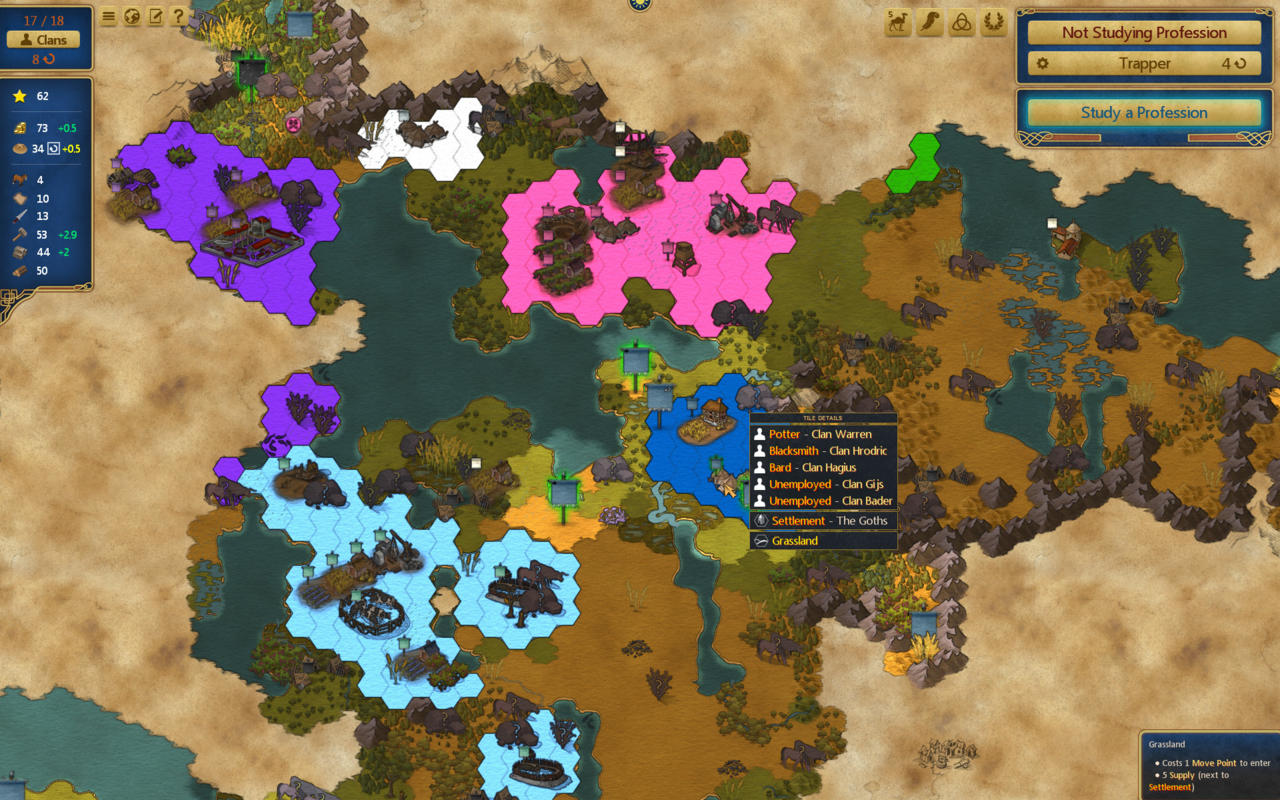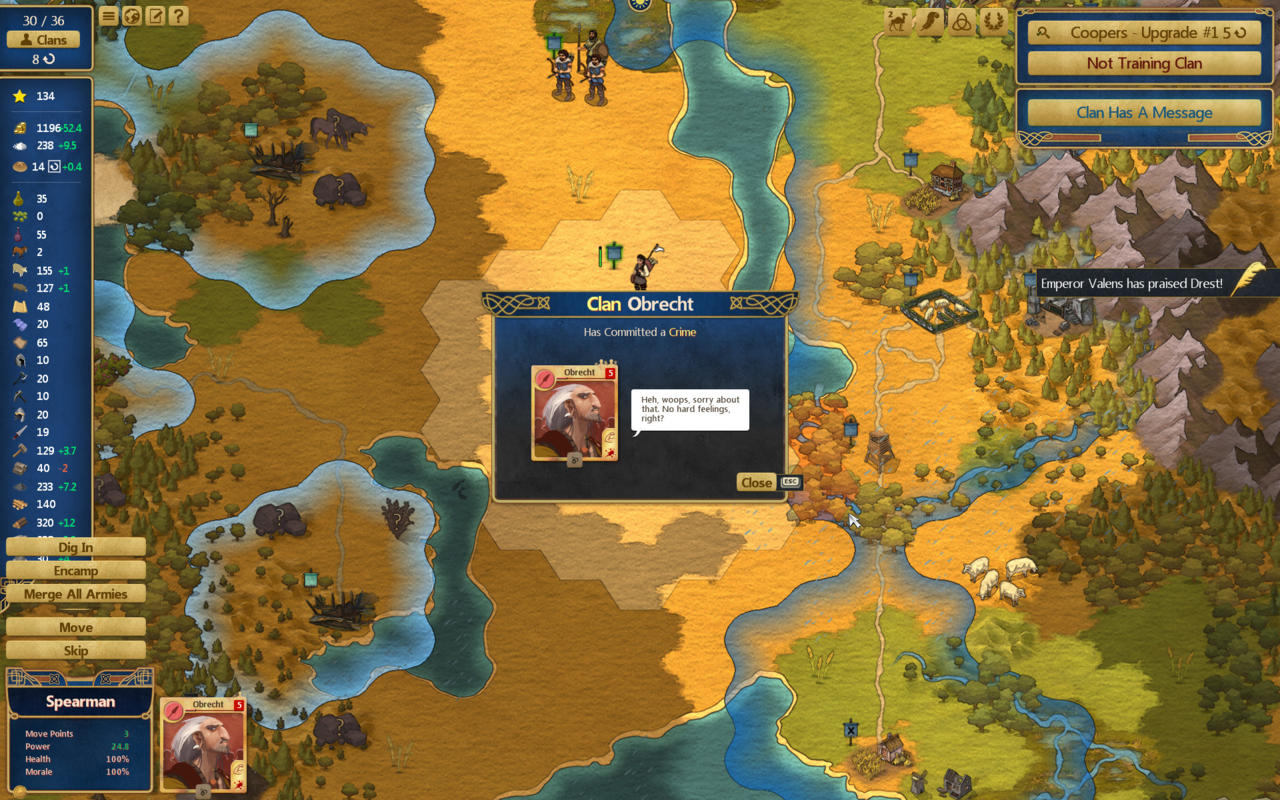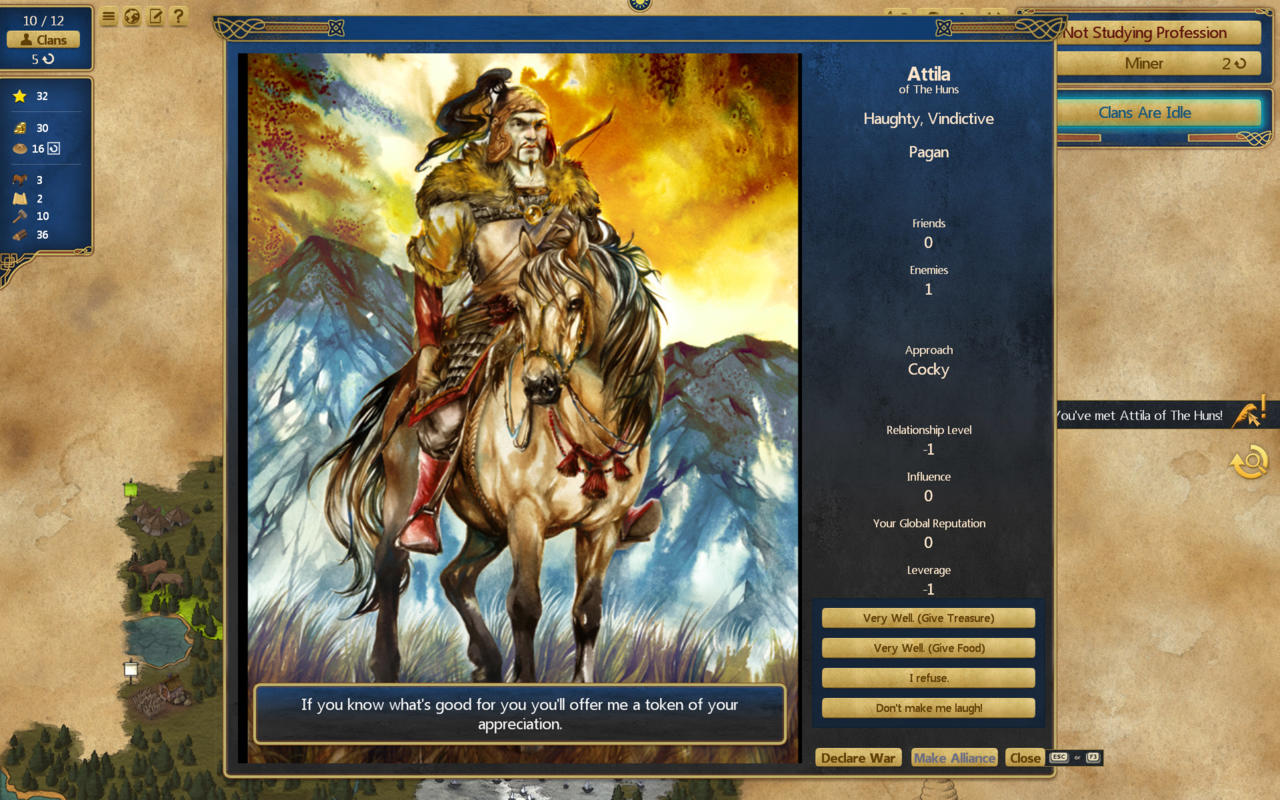In his time at Firaxis as the lead designer on Civilization V, Jon Shafer showed he wasn't afraid to uproot a settled and successful series and venture forth in search of something better. With At The Gates, his first release under the one-man studio moniker Conifer Games and his first game proper since Civ V, you get the feeling Shafer challenged himself to pack up the whole 4X genre and find fertile new ground on which to start over again.
Connections to the past remain--technologies are researched, resource nodes are exploited, wars are inevitably waged--but Shafer's pioneering vision here is of a genre that is narrower in scope and more concerned with how players respond to the figurative hand of cards they're dealt. At The Gates is a promising starting point that, with a few thoughtful additions, has the potential to develop into a thriving empire.

It all starts with a settlement. At first, you play as the Goths on a randomly generated map that represents 400 A.D. Europe. On each map is a number of rival clans, some of whom are always vastly more powerful than you are right from the start, as well as two factions of the fading, but still intimidatingly large, Roman Empire. Your aim is to grow your settlement into an empire and eventually win via one of two victory conditions: by conquering the Romans by military force or by training your own Roman Legion to assume control, i.e. an economic victory. Cleverly, factions other than the Goths are unlocked to play once you’ve met and formed an alliance with them in a previous game.
As the early turns tick by, clans of people will join the settlement and you can put them to work extracting resources from the surrounding tiles. Each clan can be trained in a profession drawn from one of six disciplines, all of which are unlocked by generating knowledge to progress through the tech tree. Early decisions are influenced by the mysteries of the randomly-generated map algorithm. If it has spawned you in an area with a lot of mineral deposits you will probably want to focus your efforts on metalworking professions, a couple of diggers to extract the iron, and, say, a dredger to multiply their production.
But how should you employ your fourth and final clan? While the map informs your strategy in certain directions, the whims of your population will often be tugging you in the complete opposite direction. Clans are randomly rolled a handful of traits when they arrive at your settlement's door. Some traits are unambiguously beneficial, like a +1 bonus to their movement points or with a few levels already earned in the crafting discipline, while others are downright bad, like a tendency to commit crimes; others yet are merely circumstantial, like preferring an active profession like explorer over a settled one like cheese-maker.
These elements quickly start to create compelling conundrums. What do you do when, on the one hand, the mineral-rich starting area of the map might be telling you to invest in mining, but on the other hand the clans you're being sent bear all the characteristics of some really effective soldiers? Or cheese-makers? Clans can, of course, be retrained as the need for new or more advanced professions arises, but it cannot be done instantly and any experience they had accumulated in their previous profession is lost. If you've only got a village of farmers and bards when the bandits turn up, you're quickly going to regret not training at least one of them to wield a spear. Balancing the demands of the map with the skills of your clans is the core strategic concern of the entire game. Along the way--and this is where At The Gates really starts to shine--there are many ways that relationship between the map and your people can change.

For one, you're not committed to your starting position on the map. In fact, at any moment you can pack up your settlement, move to a new location, and resettle. For the first 50-odd turns you'll be living something of a nomadic existence, exploring the lands, foraging for food, hunting and trapping animals, and collecting wood before moving on, crossing those mountains to the eastern coast or trekking across the steppes to the lush riverlands of the south. On a mechanical level, all the early technology you have at your disposal depletes resources--send a gatherer to work a fruit tree and they'll keep picking until the tree is exhausted. It's not until the mid to late game that you're able to build structures that don't deplete a resource and, in the case of a fruit plantation, can even replenish it. And it's at this point that you'll want to have found somewhere to make your permanent home.
This makes for an early game flow that is fascinating and unusual for the 4X genre. You want to be researching technology and training clans to suit your immediate situational needs, while also identifying (but, crucially, not yet exploiting) a resource-rich region you can later claim for your eventual empire. Sometimes this is straightforward enough--in one game I spawned on a narrow land bridge connecting two continents. I fished and picked berries until I was ready to journey southeast and declare my kingdom in a river valley full of wheat and horses. Other times it's more challenging, like the time I spawned on a tiny peninsula with only a bare handful of tiles separating my settlement from the border of the Huns. The beauty here is that even when the enemy is literally at the gates, you have enough flexibility to find an alternative--in this case, several hundred miles away, preferably.
The beauty here is that even when the enemy is literally at the gates, you have enough flexibility to find an alternative...
The map itself also intriguingly shifts in fundamental ways thanks to both seasonal and situational changes in weather. During cold months you have to worry about supplying any units traveling outside your territory, or else that scouting party might not make it back home. It's also vital to maintain a surplus of food for the winter as many of your food sources will no longer be operational. Heavy rains, flooding, and even blizzards on specific tiles also keep things interesting, as they can see units immobilized for multiple turns, potentially throwing into chaos your carefully planned assault on a rival settlement or, if you're lucky, delaying that bandit raid on your logging camp.
As the environment changes over the years, so do the people. Two clans might get into a feud and you'll be forced to pick a side. Another might be caught stealing and you'll have to decide their punishment. It's up to you to sort things out--retrain clans, shuffle them around to new locations, placate them with alcohol--before morale drops too low and everyone's unhappy. This might seem fiddly and a little prescriptive, but it's rarely as simple as it may sound. Clan Dankward may now hate Clan Waller, but the Dankwards are your best breadmakers and the Wallers your best blockcutters, you can't just send one of them out to run the sheep pasture. Besides which, the Wallers are afraid of animals and refuse to work in livestock. Working out a solution to these problems often means having to make tough decisions and uneasy compromises.

None of these clans are fleshed-out characters; they're just a collection of buffs and debuffs attached to a random name and portrait. But the way their traits and desires are expressed through their abilities and little exchanges goes a long way to make you feel like you're ruling a loose collection of real people. They're not people, of course, but they're your people.
The same cannot be said of the opponents you face, though. You’re always pitted against the same opponents on every map, but to my mind this is acceptable within the bounds of the scenario Shafer chose to depict. Instead, the more significant problem here is the lack of interaction with those AI opponents. To begin with, they don't particularly care about you--that's how small and insignificant you are in your initial nomadic phase. As you grow they start to take notice, but it's rarely more than a raised eyebrow here and there. Occasionally a dialogue box pops up and you can give a gift or rudely refuse one, and that's pretty much it until you're at war or you form an alliance. Essentially, you're either utterly indifferent to the AI, or you're their best friend or worst enemy, with barely any negotiating in between.
Indeed, it feels like the late game in general is underdeveloped. The absence of compelling diplomacy with the AI factions plays a huge part here, as for much of the game it's perfectly possible to adopt an isolationist strategy and focus on the more economically focused victory. Pursuing the military route extends your interactions with the AI to throwing your stacked military units at theirs until you occupy their settlements and structures. Combat will be familiar to anyone who’s played Civ IV and it gets the job done in a similarly efficient, if tactically unspectacular, fashion.

Even trade is handled in a curiously neutral manner, having you buy and sell goods through an anonymous caravan rather than through any interaction with the AI factions. Worse still, the concept of religion is relegated to a checkbox that has an unclear effect on an AI faction's disposition toward you. Shafer has admitted that the diplomacy features are still in their infancy and he has plans to continue to work on them post-launch. That's an encouraging sign, and one we hope also applies to these other areas, because the late game in its current form is desperately undernourished.
That makes At The Gates difficult to wholeheartedly recommend. What's there right now is undeniably good; however, what's missing makes you yearn for how good it could yet be. It's a fresh, invigorating, more personal take on the grand strategy game. But at the same time, it's lacking in a few areas, and they really do hold it back from greatness. Jon Shafer has found that fertile new ground on which to settle. He just needs to give it a few seasons to grow.





























